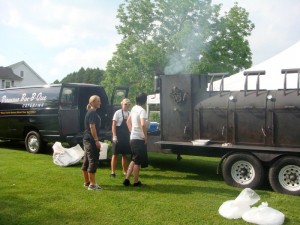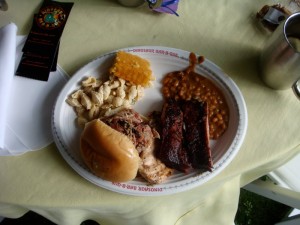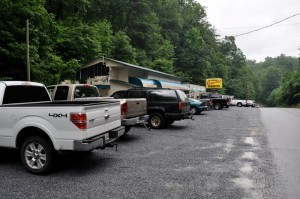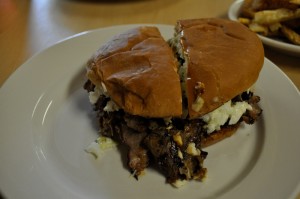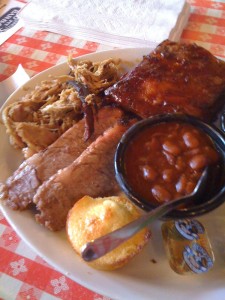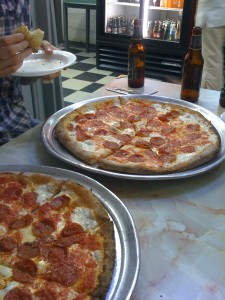This post is the second of a two-part series about the barbecue my new wife and I ate on our honeymoon. For more explanation and more porky pix, see part 1: “The West”.
JUNE 14: Hudson’s Smokehouse, Columbia, SC
We’d just finished a stint in Eastern Tennessee, where we’d enjoyed some bodacious relaxation but no phenomenal barbecue. We knew we’d have to make up for it on this comparatively short stay in the Carolinas. Our first stop en route to Charleston was chosen largely for convenience’s sake: it was not too far off our course, and we’d be passing by around lunchtime (unlike some of the more well known SC barbecue joints), and they’d be open on a Monday afternoon (again, unlike some of the more traditional joints, which are often open Thurs-Sat only).
With these conditions in mind, a bit of internetting led us to Hudson’s Smokehouse, which had gotten favorable reviews on the sites I’d checked. They had a lunch buffet that looked pretty good, but the idea all-you-can-eat fullness in the 100-degree heat followed by a few hours in the car didn’t strike us as the wisest dining decision. So we ordered off the menu: we each got the pork platter, and I got green beans and baked beans while Rebecca got sweet potato fries and collards.
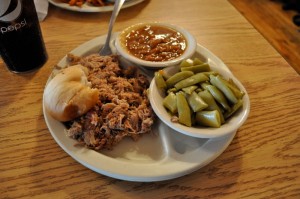
Hudson's Smokehouse
Here’s the thing: OMG. One small bite of the pork and I was rushed back to our previous barbecue vacation, when we ate our way across North Carolina, hickory smoke coursing through our veins, on a kind of high that can only be sustained with two or three different barbecue joints every day for a week. It’s not so much that Hudson’s was the best pork ever, but it had all the trappings of the great barbecue: the smoky aftertaste, the balance of cider vinegar and Texas Pete’s, the salty outside brown. It was awesome. And the sides were very, very good as well, though the sweet potato fries didn’t stand up to the rest. Evidence:
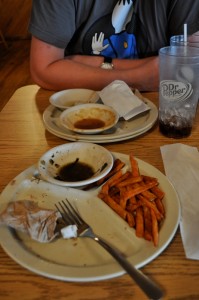
Hudson's, terminé
Nom nom nom.
June 15: Bessinger’s Barbecue, Charleston, SC
Charleston was blazing hot. Heat indices into the 110s. This is ideal weather for barbecue. Indeed, any weather is ideal weather for barbecue. We were in South Carolina, and we wanted some of the local stuff.
At Hudson’s the day before, the barbecue was Lexingtonesque, by which I mean that it was pork shoulder, served with a vinegar sauce that had just a bit of ketchup in it for color and sweetness. That’s how they do it in the western part of NC, centered around Lexington. When you talk about South Carolina barbecue, though, the mind usually goes to mustard sauce instead of ketchup. Charleston, from what I understand, is known for having a variety of native barbecue styles, but since we were in SC we wanted mustard, and my research told me to get it at Bessinger’s.
I got the pork plate, with baked beans and cole slaw. Bessinger’s is notable for throwing in an enormous onion ring with every meal as well. Let me tell you something about that onion ring: It was something else. Enormous and battered beyond recognition, it was hard to tell, even when looking closely, where the batter ended and the onion itself began. You know that problem you sometimes have where the onion and batter don’t stick to each other, and you end up pulling the whole (scorching hot) onion out on your first bite? At Bessinger’s, the onion and batter had truly become One. Was it the best onion ring I ever had? No. But I have to give them some real points for technique.
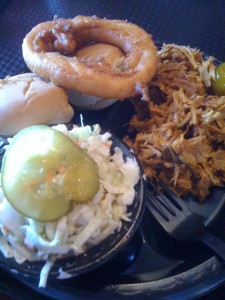
Bessinger's
The barbecue was a bit disappointing. By itself, it had just a trace of smoky flavor, and not much of the salty fatness that would have to be present to make up for the relative lack of smoke. The mustard sauce on the table was too sweet for my liking, with none of the vinegary kick that, frankly, I expect even out of a bottle of Plochman’s. The cole slaw was a generic, mayonaissey, Midwestern affair. The beans were on the sweet side for my taste, but otherwise pretty well executed. Maybe I was coming off of a high from the day before and expecting too much, but with the exception of that exceptional onion ring, I walked away a bit disappointed.
For reasons related to heat and pork fatigue and the otherwise awesome food in Charleston, this was the last barbecue meal we had in South Carolina.
June 17: Skylight Inn, Ayden, NC
Unless you are on the way to the bustling burgs of Hookerton or Vanceboro, Ayden is not on the way to anything. After getting off of I-40 North 45 minutes north of Wilmington, we spent about an hour meandering the highways of the beautiful North Carolina countryside before we started seeing signs for the small town. And when I did see those signs, I felt the kind of excitement that an adult man, having outgrown birthdays and Easter baskets, doesn’t get to feel very often. For the second time in as many years, I was headed to the Skylight Inn.
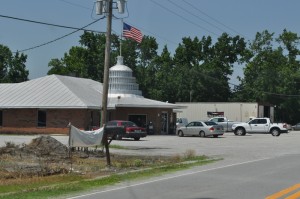
Skylight Inn, capital of my heart
My first time at the Skylight was a very special day. We were near the beginning of our barbecue trip, and already I think we were doubting the wisdom of eating So Much Pork. We drove a long way for what we had described as the best barbecue there is, and we were a bit perplexed to find a shack with a faux rotunda and a huge billboard bragging about how Ayden was the barbecue capital of the world. The menu is three lines long: 1) Sandwich. 2) Platter (small, medium, large). 3) By the pound. The platter was a paper tray heaped with chopped pork and a bit of uninspiring slaw, and laid over the top was a slab of what I would describe as corn brick.
But: That pork.
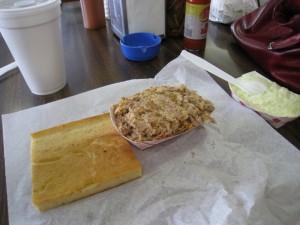
That Pork, 2008
That first bite might have been the most delicious thing I ever tasted, either before or since. Fatty, smoky, and strewn with crispy little bits of skin – the cracklins. It was so good, I washed it down with a sandwich.
My return to the Skylight thus had a lot to live up to. And, as such things often turn out, it didn’t live up. Don’t get me wrong, the pork was good, but I think that our 3pm arrival meant that we got stuff that’d been sitting under the heat lamp a bit too long. Also, they’d gone a bit light on the salt. By the end of my sandwich this time around, I had figured out the amount of vinegar and salt that needed to be added to each bite to make it great. And then: I tasted a piece of the pound I’d gotten to go, to bring back to my brother in Brooklyn. It was better, like it’d been picked from a non-dried-out part of the pork pile.
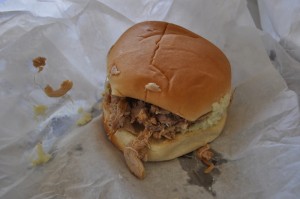
Skylight Inn, 2010
Looking back now, I really want to go back to Skylight. Like, right this instant.
June 17: Bum’s Restaurant, Ayden, NC
Bum’s, like Skylight Inn, has no website. That’s the first good sign.
After leaving the Skylight, we headed downtown (about eight blocks) to Bum’s, a joint we’d missed on our previous pass through Ayden. It was awesome. Unlike the Skylight, there were multiple steam tables of various down-home sides. We got a couple of barbecue sandwiches, along with some butter beans, collards, and beef stew to share. Everything was excellent. The pork was arguably, on that day, better than Skylight’s, and was even better when topped with the stagnant-water-colored sauce kept in a repurposed glass ketchup bottle on our table. I remember that the collards in particular were outstanding, with a great balance of vinegar tang, smoked porkiness, and bitter greeniness.
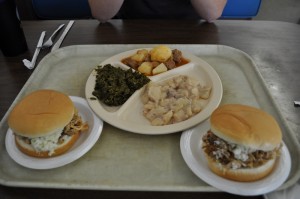
Bum's
Bum’s was a great way to wrap up the barbecue-fueled portion of our honeymoon adventure. Now I’m just looking for another excuse to get myself to the Carolinas. Or, at least, to find some decent pork here in NYC.








